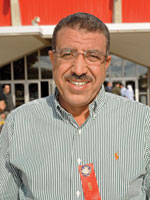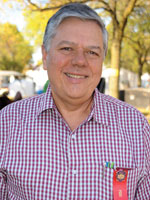Dairy Producers from Around the World

Farmers from Egypt, China, the UK and Peru tell why they come to Expo
Modern dairy farmers have a leg up on Phileas Fogg, the central character in the 1873 Jules Verne adventure novel Around the World in Eighty Days.
To engage the brightest minds from around the globe and get an up close and personal look at the technological marvels of the late 19th century, Fogg had to endure an arduous, nearly three-month-long journey, traveling by steamship, railway, hot air balloon and even elephant, facing hardship and peril at every turn.
By way of comparison, today’s dairy farmers who want to access information about the latest developments in technology, product innovation and business practices related to their industry can do so by spending five days at World Dairy Expo.
 |
| Egyptian dairy producer Mohamed Waaer says, "If you want information about anything related to the dairy business, World Dairy Expo is where you come." |
Lured by the trade show. Egyptian dairy producer Mohamed Waeer is one of the modern-day dairy adventurers Fogg would likely envy. Waeer made his first trip to World Dairy Expo in 1987 and has been back nine times since. "I’ve been to several dairy shows in Europe," Waeer says. "But there is really no comparison. This is definitely the king of shows. If you want information about anything related to the dairy business, this is where you come."
Waeer is manager of Dina Farms, located in the desert between Cairo and Alexandria. With 6,000 milking cows (registered Holsteins) and another 6,000 head of dry cows and young stock, Dina is the largest dairy in Egypt. "All of our cows originated in the U.S.," Waeer says, noting that the dairy plans to expand to 14,000 milking cows by the end of 2012. "I usually arrange my trips here to select cows in September and October. It’s the best time to ship animals to the Middle East, and it’s also when World Dairy Expo is going on."
While he enjoys attending Expo’s breed shows and having the opportunity to exchange ideas and information with his fellow dairy producers from all over the world, the commercial trade show is the real lure of Expo for Waeer. "Representatives from all of the major companies are here," he says. "I spend a lot of time collecting brochures and getting contact information. Then I go back home and meet with my suppliers, describe what I saw here and explain how they can get in contact with the exhibitors I met here.
"Over five days in this one place, you can gather so much information on the newest technologies, products and practices. Each time we’ve come here, we’ve found something new that we can use to make our business better. It is the best."
 |
| "America is the leader in dairy management," says Pu Wan Xiong, division manager of Beijing Sanyuan Lvhe Dairy Group in China (left, with Bill Zhao, a business associate). "Coming to World Dairy Expo benefits us greatly." |
Learn new production ideas. Pu Wan Xiong, the manager of the service division of Beijing Sanyuan Lvhe Dairy Group in China, expresses similar thoughts about the trade show at World Dairy Expo. "It is very helpful to meet with the company representatives here and gather ideas about what is new in the industry," he says.
The Sanyuan Lvhe Dairy Group manages 40,000 Holstein cows on 22 core farms and 12 additional farms operated with collaborative partners. During his three trips to World Dairy Expo, Pu has had the opportunity to get an up close look at many products that he can put to use immediately on the dairies. On his first visit to Expo in 2008, for example, he was impressed by the individual calf housing concepts being touted by several exhibitors.
"We weren’t separating our newborn calves," he says. "But we could immediately see the benefits of rearing calves this way. We made arrangements to buy some of the housing while we were here, and now we raise all of our calves this way."
Other products Pu remembers seeing for the first time during his visits to Expo include hoof trimming equipment, rubber mats for freestalls, teat dipping products and a variety of feed products. "There is so much to see here in one place, it is hard to pick out the individual products and technologies that have stood out over the years," he says. "Every time we come here, we learn so much."
 |
| UK dairyman Robert Reed says that getting to all of the exhibitor booths at Expo can be a challenge. |
Different every time. "Looking, learning and asking questions," sums up what the World Dairy Expo experience is all about for British dairy producer Robert Reed.
"I enjoy going to some of the breed shows, of course. The cattle are very impressive," says Reed, who milks 300 registered Holsteins near Devon. "But the fantastic trade show is what really brings me here. I try to get to as many of the stands [exhibitor booths] as I can to see and learn about all of the things that are new and different in the dairy business."
Dating back to 2004, Reed has now made four visits to Expo. He typically spends a week or so in the U.S., combining several days at Expo with visits to Midwestern dairy farms.
"The biggest thing I notice is how dynamic the U.S. dairy industry is," Reed says. "It seems like each time I come back, there have been major changes. There’s been more investment, more expansion and new technologies put to work. It’s impressive. It shows a lot of confidence on the part of the U.S. farmers and the dairy industry as a whole."
Reed notes that the things he’s seen at Expo have led him to alter the way he approaches dairy farming. He’s purchased a variety of equipment from companies whose exhibits he’s visited during the show, including freestall loops, headlock yokes, silage facers and a machine for distributing sand in freestalls. "We have some of these things in the UK," he says. "But what you notice here is how much variety there is. You can find several companies with the same kinds of products and get information that allows you to compare one to the other while you’re here."
During last year’s visit to Expo, Reed had a special mission: gathering information that he could use to make a decision about a new milking parlor he’s planning to install on his dairy. "We were thinking about going with either a parallel parlor or a herringbone parlor," he says. "We had done a lot of research on it already. But here at the show, we were able to talk to representatives from several companies about the advantages of each type of parlor. After doing so, we decided on the parallel because it would be safer for our staff."
 |
| South American dairy producer Robert Watson has been coming to Expo for 20 years. He appreciates the virtual farm tours, where "the best managers in the U.S. share a lot of information you can learn from." |
New and old friends. Having an opportunity to get a glimpse of the future of the dairy industry has kept South American dairy producer Robert Watson coming back to World Dairy Expo year after year for the past 20 years. "This is where I come to see where the industry is moving to," says Watson, who owns a 600-head dairy near Lima, Peru, and two dairies, totaling 300 animals (150 milking cows), near Quito, Ecuador.
Watson finds the educational seminars and virtual farm tours to be extremely valuable. "There are great speakers at the seminars, people who are on the cutting edge," he says. "And with the farm tours, you get to see how some of the best managers in the U.S. run their business."
The commercial trade show is also a wealth of information. "There is always something new," he says. "And here, you can find just about everything. Over the years, I’ve found that every time I have a need for something, I come to the show and learn that someone has already come up with a solution. It’s a matter of keeping your eyes open."
Watson notes that a lot of the equipment, structures and products he currently uses on his farms—freestalls, a total mixed ration mixer, milk replacement bottles, etc.—have a direct connection to Expo. "I either bought it here at the show or bought it later because I had seen it while I was at the show," he says.
One of the best things about the trade show, Watson says, is that it offers the opportunity to talk directly to company representatives. Last year, he came to the show looking to get more information on calf hutches. "The hutches we have are 20 years old," he says. "I talked to representatives from several different companies. I eventually decided to buy from one company because I was impressed by the way the people handled our interview session. It told me that they would stand behind their product after I purchased it. It’s not always just about the lowest price."
Watson also makes it a point to take in several breed shows at Expo. While most of the cows on his farms are Holsteins, he also has Jerseys, Brown Swiss, Normande and Montbéliarde. "I get to see the daughters of the bulls that I’m using and thinking about using," he says. "It is so much better than just buying semen based on what you see in the sales catalogues or talking to salespeople from the genetics companies. There’s nothing as valuable as seeing those animals up close and making your own evaluation right on the spot."
But even Watson says that having the chance to interact informally with fellow dairy producers from all over the world may well be the very best part of the Expo experience. "Over the years, I’ve made so many friends here," he says. "We look forward to getting together and sharing information. We ask each other about what we have been doing, what has been working and what hasn’t been working. It’s a great way to learn and get better. And the best thing is that, each year, there are new friends to make."







